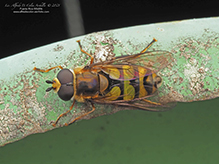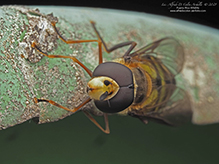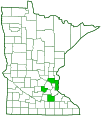undivided lucent
(Didea fuscipes)
Conservation • Description • Habitat • Ecology • Distribution • Taxonomy
Conservation Status |
|
|||||||
| IUCN Red List | not listed |
|||||||
| NatureServe | NNR - Unranked |
|||||||
| Minnesota | not listed |
|||||||
Description |
||
Undivided lucent is a large, widespread but uncommon, hover fly. It occurs in the United States and southern Canada in three geographically separated regions. In the east it occurs from New Brunswick to South Carolina, west to Minnesota and eastern Texas. In the west it occurs from southern British Columbia and Alberta, south to northern California. Another population occurs from western Nebraska south to New Mexico and eastern Arizona. Undivided lucent is uncommon throughout these ranges. It is found from June to October in forests, forest edges, and bogs. The larvae feed on tree-dwelling (arboreal) aphids, especially giant bark aphids, and are often found in basswood and sycamore trees. Adults are ⅜″ to ⅝″ (9.7 to 15.0 mm) in length. The head is wider than the thorax. There are two large compound eyes on the sides of the head and three small simple eyes (ocelli) in a triangle on top of the head. The compound eyes have extremely sparse, moderately long hairs, and there is a fringe of yellow hairs at the back of each eye. On the male the eyes meet at the top of the head. On the female they do not. The face is mostly yellow, including the lower margin. There is a narrow brown stripe in the middle of the lower half, but this is sometimes indistinct. On the male, there is a small dark spot above the base of each antenna. On the female, the spots converge to form a long, inverted, Y-shaped mark that extends to the top of the head. The arms of the “Y” are narrower than the space between them. The protruding mouthpart (proboscis) is short and fleshy. The antennae are short and have just three segments. The third segment is large, twice as long as wide, and has a stiff, forward-pointing bristle (arista) on the upper side. The exoskeletal plate on the first segment of the thorax (scutum) is large, shiny, and greenish black. It is covered with short, erect, yellow hairs, densely on the sides, sparsely above. The exoskeletal plate between the abdomen and thorax (scutellum) is large, rounded, dull yellow, and translucent. It is covered with pale yellow hairs on the front third or more, black hairs on the rear half or more, and it has a moderately dense fringe on the rear margin. In the western population, the scutellum on the female is black. The abdomen is longer and broader than the thorax, oval when viewed from above, and nearly flat when viewed from the side. It is black with yellow to translucent markings. There are five visible segments (tergites). The sides of each tergite are narrowly extended and flattened (margined). The first tergite (T1) is very narrow and entirely black. T2 has a pair of broad, oblique spots that do not meet in the middle. T3 and T4 each have a broad yellow band that does not quite reach the lateral margins. The forward margin of each band is nearly straight, the rear margin is deeply narrowed in the middle but never interrupted. This is the feature that gives the species its common name. On the male T5 usually has a yellow spot on each side but is always at least somewhat yellowish or reddish in front on each side. On the female T5 has a yellow band that is similar to that on T3 and T4, but it is much narrower, and it is sometimes interrupted in the middle. The legs are black and yellow. The wings are clear and are mostly covered with short erect hairs. There is a spurious vein between the radius (R) and media (M) veins. The anal cell is long and is closed near the wing margin. The marginal, R5, and M2 cells are also closed. The R4+5 vein is distinctly sinuous, dipping deeply into the r4+5 cell. |
||
Size |
||
⅜″ to ⅝″ (9.7 to 15.0 mm) |
||
Similar Species |
||
Habitat |
||
Forests, forest edges, and bogs |
||
Ecology |
||
Season |
||
June to October |
||
Behavior |
||
|
||
Life Cycle |
||
|
||
Larva Food |
||
Arboreal aphids, especially giant bark aphids (Longistigma caryae) |
||
Adult Food |
||
|
||
Distribution |
||||
|
Sources |
|||
| 5/27/2023 | ||||
Occurrence |
||||
Uncommon |
||||
Taxonomy |
|||
Order |
|||
Suborder |
Brachycera |
||
Infraorder |
Cyclorrhapha |
||
| Zoosection | Aschiza |
||
Family |
Syrphidae (Hover Flies) |
||
Subfamily |
Syrphinae (Typical Hover Flies) | ||
Tribe |
Syrphini |
||
Genus |
Didea | ||
A similar but new species in Oregon, Didea pacifica, was described in 1919. It varied from Didea fuscipes in being smaller and having black cheeks, a black scutellum, darker legs, and wholly transparent wings. It is now treated as a synonym of Didea fuscipes. |
|||
Synonyms |
|||
Didea pacifica |
|||
Common Names |
|||
undivided lucent |
|||
Glossary
Arista
A large bristle on the upper side of the third segment of the antenna of a fly. Plural: aristae.
Ocellus
Simple eye; an eye with a single lens. Plural: ocelli.
Proboscis
The tube-like protruding mouthpart(s) of a sucking insect.
Scutellum
The exoskeletal plate covering the rearward (posterior) part of the middle segment of the thorax in some insects. In Coleoptera, Hemiptera, and Homoptera, the dorsal, often triangular plate behind the pronotum and between the bases of the front wings. In Diptera, the exoskeletal plate between the abdomen and the thorax.
Scutum
The forward (anterior) portion of the middle segment of the thorax (mesonotum) in insects and some arachnids.
Tergite
The upper (dorsal), hardened plate on a segment of the thorax or abdomen of an arthropod or myriapod.
Visitor Photos |
|||||
Share your photo of this insect. |
|||||
| This button not working for you? Simply email us at info@MinnesotaSeasons.com. Attach one or more photos and, if you like, a caption. |
|||||
Alfredo Colon |
|||||
 |
 |
||||
MinnesotaSeasons.com Photos |
|||||
|
|||||

Slideshows |
||

Visitor Videos |
|||
Share your video of this insect. |
|||
| This button not working for you? Simply email us at info@MinnesotaSeasons.com. Attach a video, a YouTube link, or a cloud storage link. |
|||
Other Videos |
|||

Created: 5/27/2023
Last Updated:


